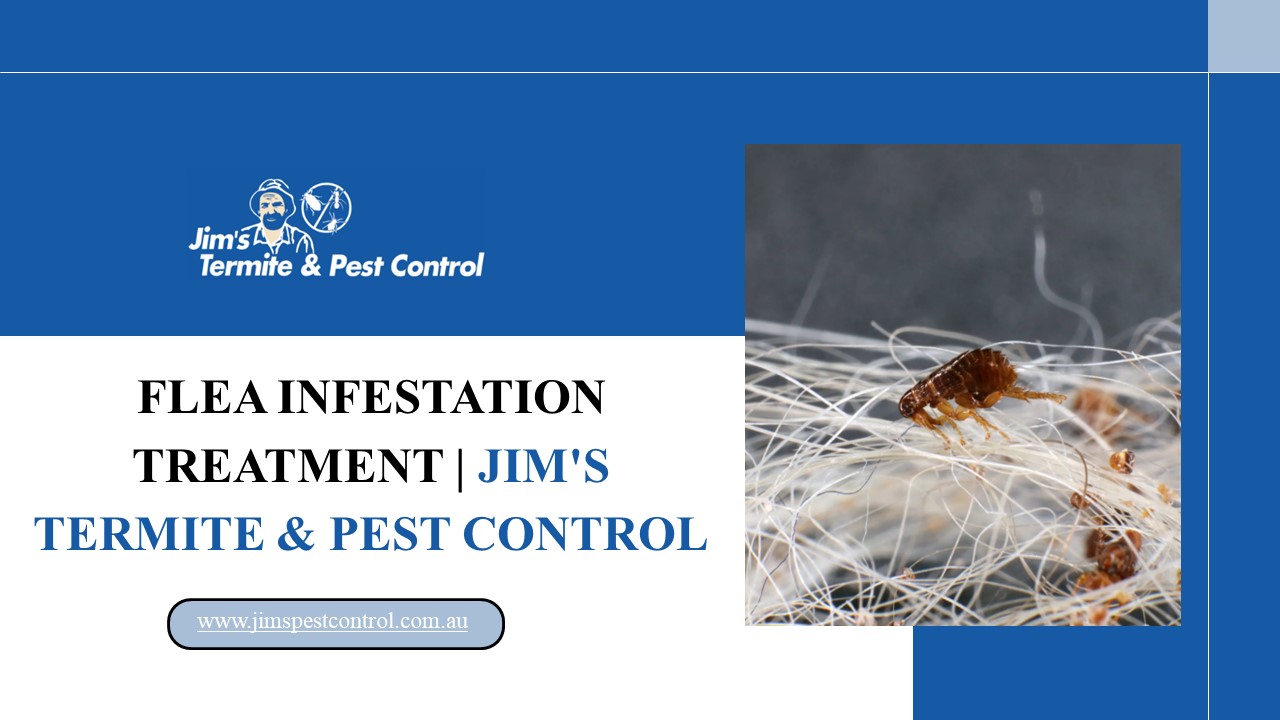Flea Infestation Treatment Jim's Termite & Pest Control
Title:
Flea Infestation Treatment Jim's Termite & Pest Control
Description:
Discover top-notch flea treatment solutions at Jim's Pest Control. Safeguard your home from flea infestation with our expert pest control services. Say goodbye to creepy crawlies with our proven methods. Trust Jim's Pest Control for a pest-free environment. For More Information Visit Our Website: www.jimspestcontrol.com.au/our-services/creepy-crawlies/fleas –
Number of Views:2
Title: Flea Infestation Treatment Jim's Termite & Pest Control
1
FLEA INFESTATION TREATMENT JIM'S TERMITE PEST
CONTROL
www.jimspestcontrol.com.au
2
FLEA PEST CONTROL
At Jims Termite Pest Control, we understand
the frustration and discomfort of dealing with a
flea infestation. Fleas are known to spread
disease and can quickly become a major problem if
not dealt with promptly. Thats why we offer
comprehensive flea pest control services to
eliminate these pests and prevent them from
returning. Our team of experienced technicians is
trained to identify the signs of a flea
infestation and implement effective treatment
options to eradicate the infestation. We use a
range of flea control methods, including chemical
treatments and vacuuming, to target fleas at all
stages of their lifecycle.
3
FLEAS
Fleas are a common nuisance in Australia,
affecting pets and humans. With a diverse range
of ecosystems and a warm climate, Australia
provides an ideal breeding ground for fleas.
These tiny, wingless insects thrive in humid
environments, making coastal regions and tropical
areas particularly prone to flea infestations. As
a result, pets, such as dogs and cats, often
suffer from itching and discomfort caused by flea
bites. Additionally, fleas can transmit diseases
like murine typhus and cat scratch fever, posing
a health risk to animals and humans. Therefore,
vigilance in regular pet grooming, flea
prevention treatments, and maintaining a clean
living environment is essential in combating flea
populations in Australia.
4
HOW CAN I TELL IF MY PET HAS FLEAS?
Several signs may indicate your pet has
fleas 1. Excessive Scratching If you notice
your pet scratching, biting, or licking
themselves more than usual, it could be a sign of
fleas. Pay attention to the neck, back, tail
base, and hindquarters. 2. Flea Dirt Fleas
leave behind dark, pepper-like specks called flea
dirt. You can identify flea dirt by combing or
parting your pets fur and looking for tiny black
or brown flecks. To confirm if its flea dirt,
place the dots on a damp paper towel if they
turn reddish-brown, its likely flea dirt. 3.
Visible Fleas In some cases, you may be able to
spot fleas on your pet. They are small,
brownish-black insects that move quickly through
the fur. Check areas with less hair, such as the
belly and inner thighs.
5
CAN FLEAS AFFECT HUMANS?
Yes, fleas can affect humans. While fleas
primarily infest and feed on animals, they can
bite humans and cause discomfort. Flea bites on
humans usually appear as small, red, itchy bumps,
similar to mosquito bites. However, some people
may be allergic to flea saliva, leading to more
severe itching, redness, and swelling. In
addition to the physical irritation caused by
flea bites, fleas are prone to transmitting
diseases to humans. Certain flea species can
carry and transmit diseases such as murine
typhus, cat scratch fever (bartonellosis), and
even the bubonic plague (though rare). These
diseases are typically associated with specific
types of fleas and certain regions, but its
essential to be aware of the potential health
risks.
6
HOW CAN I PREVENT FLEAS?
Preventing fleas requires a combination of
measures targeting your pets and their living
environment. Here are some practical ways to
control fleas 1. Use Veterinarian-Approved Flea
Control Products Regularly use flea control
products recommended by your veterinarian, such
as spot-on treatments, oral medications, or flea
collars. These products help kill fleas and
prevent infestations. Follow the instructions and
dosage guidelines for your pets weight and
species. 2. Maintain Good Pet Hygiene Regularly
groom your pets by combing or brushing their fur.
This helps to detect fleas early and remove any
adult fleas present. Additionally, give your pets
regular baths with flea-repelling shampoos or
soaps to kill any fleas on their bodies.
7
THANK YOU
www.jimspestcontrol.com.au































